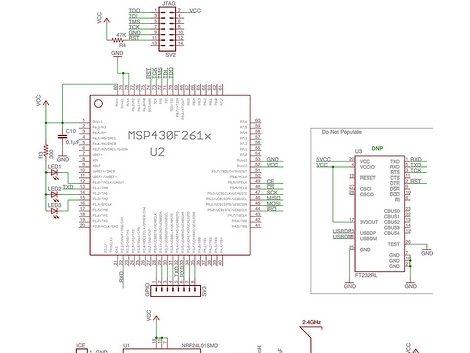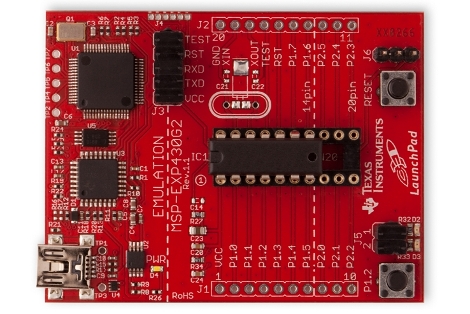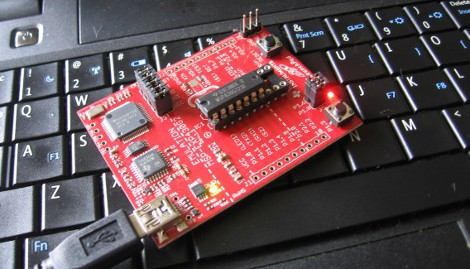When TI released their Launchpad development board at the end of June it generated a lot of Buzz. Here’s a package that delivered a programmer, debugger, two microcontrollers, and some accessories for less than five bucks (including shipping). They even provided a choice of two software suites but only for users running Windows who don’t mind proprietary software. If you’re looking to go another way you should consider trying out the open source alternative MSPGCC. After the break we’ll take a look at getting the tool-chain up and running in a Linux environment.
msp430129 Articles
MSP430 Based Single LED Clock

[Kenneth Finnegan’s] latest clock makes use of the TI Launchpad for programming and debugging MSP430 microprocessors. We took a look at the Launchpad when it was released and we’re glad to see some hacks resulting from availability of that tool. The clock reads out the time using a bi-color LED. Press the button and a series of flashes will tell you the time. A three-position toggle switch is used along with the push button for setting the time. The protocol he developed is outlined in his demo video after the break.
We like [Kenneth’s] use of a plastic electrical box as a project box. They’re cheap and you can find them everywhere in many different sizes. He mentions the difficulty in drilling through the faceplate. We’ve had our share of shattered plastic trying to drill holes in the darn things. If you’ve got some tips on faceplate-modification we’d love to hear them.
This clock is sure the polar opposite from the TTL clock that [Kenneth] showed us back in March, trading jumper wires for lines of code. We’re going to give this one a try, hopefully fixing the button debounce along the way.
HOPE Badge Proximity Sensor

The HOPE conference was last weekend and [Nathan] spent some time with fellow members of Makers Local 256 developing this badge proximity sensor. They took one of the HOPE badges, which have a radio on board for the tracking network, and wrote code for its MSP430 to detect other badges nearby. It uses a Geiger counter they brought with them as an enclosure, re-purposing the analog gauge to reflect the level of active radio signals in the area. You’ll find their demo clip embedded after the break.
If you managed to get your hands on one of these badges, don’t be shy about sharing your hacks. We want to see them.
Next HOPE Badge Hacking Primer

[Travis Goodspeed] is taking a look at the attendee badges for this year’s Next HOPE conference. He’s given us a pretty good look at what is on the board, what it means to you, and how you can get at it. Of course the final hardware specs are a secret until conference time, but this will help you get some ideas and ensure that you bring the right add-on hardware. We normally try not to do too much quoting, but one of [Travis’] statements literally makes us laugh out loud (as opposed to what most people describe as lol):
“These badges are active RFID tags which beacon the position of each attendee a few times a second, so that the god damned devil army of lies–by which I mean the Next HOPE badge committee–can track each attendee around the Hotel Pennsylvania.”
No matter how you feel about the badge committee, the tradition of hacking conference badges is a fun, rewarding, and often frustration past-time. The badges are actually using the concept of OpenAMD. The last three letters stand for Attendee Meta Data which is an evolving concept. How can meta data about attendees be useful to all involved in a non-invasive way? How about associating yourself with a concept, like microcontroller programming. What if you could search to find out where other people interested in that are right now? Could be great… could end up in an impromptu meeting around the restrooms for no good reason. Either way, take a look at the teaser video covering the topic after the break.
Oh, one more note about the hardware. This year they’re moving away from PIC based badges to the more energy-efficient MSP430 line. It’s not one of the value-line processors that the Launchpad is meant for, but this bigger-brother ‘F’ chip will be no problem to work with if you’ve already spent some time with the ‘G’ series.
TI Makes A Big Bid For The Hobby Market

This morning Texas Instruments unveiled Launchpad, a development platform for their low-cost MSP430 line of microcontrollers. We’ve seen these chips before, most notably in the ez430 Chronos sports watch. We see this as a bid for the hobby market currently enjoyed by Arduino, PIC, AVR, and others. TI’s biggest selling point is price, but we’re going to wait to share that with you. Join us after the break to see what the package offers, then decide if the price is right.
Swarm Light At Art Basel

What has 9000 LEDs, 3000 MSP430 processors, six XMOS XC-2 Ethernet modules, and goes blinkity-blink-blink? It’s Swarm Light, an art installation shown at this year’s Art Basel exhibition. [Fredrik Petrini] worked on the hardware that went into building the group of three 3D cubes of LED light modules. Unlike so many art pieces we see he shared the design details of the piece. In the image above you can tell that each cube encompasses several rods of LED modules. Each rod as three rails that provide power, ground, and serial data in addition to serving as the physical structure. Each module has three LEDs on it controlled by one MSP430 processor. The XMOS units each control half of the rods in a cube, getting their instructions over an Ethernet connection from a PC running a program on a .NET framework. It would be an understatement to say this is just a upscaled LED cube. Check out the exhibit in action after the break. It uses an algorithm to analyze the music, taking input from the ambient sound in the room, to control the light fluctuation.
Pong On Your Wrist

[John] wanted to take a pong clock and put it in a wristwatch form factor. Take an afternoon and pour over his detailed build logs. This multi-year project is done with meticulous cleanliness that makes us jealous. He’s milled the case and buttons himself, achieving a professional look that equals or surpasses the quality of some commercially available “gaming” watches. The project centers around an OLED display driven by a TI MSP430F2013 processor. Don’t miss the video after the break covering prototyping, PCB work, case milling, and the watch in action. Currently, this is the third generation of development but with a project this exciting, are you ever really finished? Continue reading “Pong On Your Wrist”











